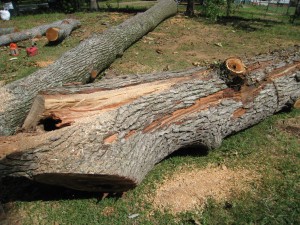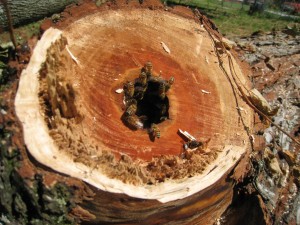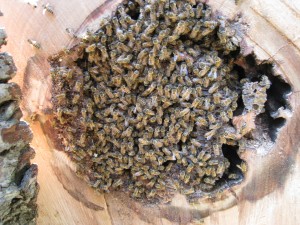The Small Hive Beetle
The Small Hive Beetle is another one of those lovely gifts that beekeepers received from across the seas. The critter originated in Africa. Oddly, one would expect that the Beekeeper’s of Europe would have encountered them as well, but maybe the beetle could never survive the trip through the Middle East…
At any rate, this Bug likes to eat sweet stuff. Fruit, honey, sugar water…you name it. As an adult, it will sneak into a beehive and lay eggs in an out of the way location. Once the eggs hatch, a nasty little larva crawls around and eats honey, comb and brood (that’s right…brood…) The honey bee fights it off, chasing the parents out of the hive and cleaning up the eggs. I am guessing that they will also kill the small larva if given the chance. Once the larva is full, it crawls out of the hive and digs into the ground, mutating back into the beetle (see my Small Hive Beetle page for thoughts on nemotodes that might fight this.) Then, it just flies back up and starts laying eggs again…
But, this all assumes a strong hive. A weak hive can fall behind the beetles and end up with a nest of larva climbing through everything. To make matters even worse, they defecate in the wax and this is one substance that the bees turn their noses up at. They will not clean it out and can/will eventually abscond from a hive that is full of these little beasts.
Now, back to my beekeeping adventures near Richmond, Virginia. The Small Hive Beetle (aka SHB) has been slowly working its way up the coast over the past several years. Like the Varroa Mite, it can overwinter in the warmth of the hive’s cluster. But, it has had a hard time getting a toehold in the more temperate regions (it is a tropical bug, after all.) Still, the State Apiarist noted that central Virginia had its first SHB around 2005. He says that they will cover all of Virginia soon enough, so get ready for them.
Well, I have them. I had them last year, but only a few running here and there. This year, they seem to be everywhere. I think the early warm season gave them a bit of an advantage. Tomorrow, I will take a look at my small hives to see how they are faring, but the reason for this post centers on the Southside Hive.
About 6 days ago, I decided that I should give the Southside Hive some pollen substitute to help them get going. I had just sucked them out of a tree and they had no resources at all. I could see that they were storing nectar, but was unsure if they were getting enough pollen. Like an idiot, I tore off a small chunk (maybe the size of a silver dollar) and pushed it through the entrance (I could not lay it on top, as I have a hive top feeder on this hive right now.)
Well, I checked the pollen sub this morning, to see if they were using it, and found that they were not. Instead, as I pulled it out and turned it over, about a dozen SHB larva were crawling all through it! Ugh! These things are nasty. I wish I had snapped a picture, but I was so pissed that I dropped them on a rock and smashed the living bejesus out of them. Hopefully, I caught this in time and did not endanger the hive any. But, it has me wondering what is going on under the feeder. In addition, I thought I noticed a weird smell from the Berkley Hive the other day (it also has a top feeder – another thing that attracts the cursed bug). At the time, I thought that maybe the syrup was getting ripe (you cannot leave the feed, which is basically water and sugar, out in this heat for too long before it begins to ferment.) But, they were almost finished and I just figured I would swap that feeder out for a clean one tomorrow.
At any rate, this post reflects a big lesson for me. Once SHB weather is here, do not feed Pollen Sub. In this case, the bees will have to make it on their own. Natural Selection. If I give them the sub, I am only stacking the deck against what might otherwise be a strong gene pool. At any rate, I hope that I do not have to cull frames tomorrow, to get rid of a SHB problem. I might be going to the store to get some materials for a homemade trap…



